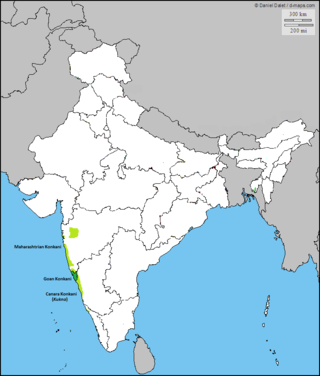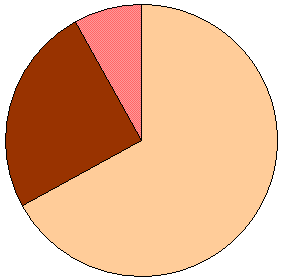This is a list of words in the English language that originated in the languages of India.
This is a list of words in the English language that originated in the languages of India.

Marathi is an Indo-Aryan language predominantly spoken by Marathi people in the Indian state of Maharashtra. It is the official language of Maharashtra, and an additional official language in the state of Goa used to reply provided the request is received in Marathi. It is one of the 22 scheduled languages of India, with 83 million speakers as of 2011. Marathi ranks 13th in the list of languages with most native speakers in the world. Marathi has the third largest number of native speakers in India, after Hindi and Bengali. The language has some of the oldest literature of all modern Indian languages. The major dialects of Marathi are Standard Marathi and the Varhadi dialect.

Urdu is an Indo-Aryan language spoken chiefly in South Asia. It is the national language and lingua franca of Pakistan, where it is also an official language alongside English. In India, Urdu is an Eighth Schedule language the status and cultural heritage of which are recognised by the Constitution of India; and it also has an official status in several Indian states. In Nepal, Urdu is a registered regional dialect and in South Africa it is a protected language in the constitution. It is also spoken as a minority language in Afghanistan and Bangladesh, with no official status.

Shri is a Sanskrit term denoting resplendence, wealth and prosperity, primarily used as an honorific.
Indian English (IE) is a group of English dialects spoken in the Republic of India and among the Indian diaspora. English is used by the Indian government for communication, along with Modern Standard Hindi, as enshrined in the Constitution of India. English is also an official language in seven states and seven union territories of India, and the additional official language in seven other states and one union territory. Furthermore, English is the sole official language of the Indian Judiciary, unless the state governor or legislature mandates the use of a regional language, or if the President of India has given approval for the use of regional languages in courts.

Languages spoken in the Republic of India belong to several language families, the major ones being the Indo-Aryan languages spoken by 78.05% of Indians and the Dravidian languages spoken by 19.64% of Indians; both families together are sometimes known as Indic languages. Languages spoken by the remaining 2.31% of the population belong to the Austroasiatic, Sino–Tibetan, Tai–Kadai, and a few other minor language families and isolates. According to the People's Linguistic Survey of India, India has the second highest number of languages (780), after Papua New Guinea (840). Ethnologue lists a lower number of 456.

Bhojpuri is an Indo-Aryan language native to the Bhojpur-Purvanchal region of India and the Terai region of Nepal. It is chiefly spoken in eastern Uttar Pradesh, western Bihar and western Jharkhand in India as well as western Madhesh and eastern Lumbini in Nepal. It is an eastern Indo Aryan language and as of 2000 it is spoken by about 5% of India's population. Bhojpuri is a descendant of Magadhi Prakrit and is related to Maithili, Magahi, Bangla, Odia, Assamese, and other eastern Indo-Aryan languages.
Bombay Hindi, also known as Bambaiya Hindi or Mumbaiya Hindi, is the Hindustani dialect spoken in Mumbai, in the Konkan region of India. Its vocabulary is largely from Hindi–Urdu, additionally, it has the predominant substratum of Marathi-Konkani, which is the official language and is also widely spoken in the Konkan division of Maharashtra. Bombay Hindi also has elements of Gujarati.
A nasal vowel is a vowel that is produced with a lowering of the soft palate so that the air flow escapes through the nose and the mouth simultaneously, as in the French vowel /ɑ̃/ or Amoy []. By contrast, oral vowels are produced without nasalization.

Konkani is an Indo-Aryan language spoken by the Konkani people, primarily in the Konkan region, along the western coast of India. It is one of the 22 scheduled languages mentioned in the Indian Constitution, and the official language of the Indian state of Goa. It is also spoken in Karnataka, Maharashtra, Kerala, Gujarat as well as Damaon, Diu & Silvassa.
The renaming of the cities in India started in 1947 CE following the end of the British imperial period. Several changes were controversial, and not all proposed changes were implemented. Each had to be approved by Government of India in Delhi.

Bengali is one of the Eastern Indo-Aryan languages, which evolved from Magadhi Prakrit, native to the eastern Indian subcontinent. The core of Bengali vocabulary is thus etymologically of Magadhi Prakrit origin, with significant ancient borrowings from the older substrate language(s) of the region. However, in medieval times, more borrowings have occurred, from Sanskrit, Arabic, Classical Persian, Turkic and other languages has led to the adoption of a wide range of words with foreign origins; thus making the origins of borrowed words in the Bengali vocabulary numerous and diverse, due to centuries of contact with various languages.
Indian English has developed a number of dialects, distinct from the General/Standard Indian English that educators have attempted to establish and institutionalise, and it is possible to distinguish a person's sociolinguistic background from the dialect that they employ. These dialects are influenced by the different languages that different sections of the country also speak, side by side with English. The dialects can differ markedly in their phonology, to the point that two speakers using two different dialects can find each other's accents mutually unintelligible.

The Naga Morich is a chili pepper grown in Northeast India and Bangladesh. There is no consensus on whether this is synonymous with the Bhut Jolokia, or a different variety. It is also one of the hottest known chilli peppers and the only naturally occurring chili pepper that measures 1 million SHU on Scoville scale. Morich is the word for chilli pepper in Bengali, with similar words in Assamese:, Nepali, Hindi and the languages of Nagaland and Manipur. Naga Mircha is registered under the Geographical Indications (GI) of Nagaland by Government of India.
The phonology of Bengali, like that of its neighbouring Eastern Indo-Aryan languages, is characterised by a wide variety of diphthongs and inherent back vowels.
Tatsama are Sanskrit loanwords in modern Indo-Aryan languages like Assamese, Bengali, Marathi, Nepali, Odia, Hindi, Gujarati, and Sinhala and in Dravidian languages like Tamil, Kannada and Telugu. They generally belong to a higher and more erudite register than common words, many of which are directly inherited from Old Indo-Aryan (tadbhava). The tatsama register can be compared to the use of loan words of Greek or Latin origin in English.
Indic Computing means "computing in Indic", i.e., Indian Scripts and Languages. It involves developing software in Indic Scripts/languages, Input methods, Localization of computer applications, web development, Database Management, Spell checkers, Speech to Text and Text to Speech applications and OCR in Indian languages.

Bengali, also known by its endonym Bangla, is an Indo-Aryan language native to the Bengal region of South Asia. With approximately 240 million native speakers and another 41 million as second language speakers as of 2021, Bengali is the sixth most spoken native language and the seventh most spoken language by the total number of speakers in the world. It is the fifth most spoken Indo-European language.
A bhoota or bhuta is a supernatural creature, usually the ghost of a deceased person, in the popular culture, literature and some ancient texts of the Indian subcontinent. Interpretations of how bhootas come into existence vary by region and community, but they are usually considered to be perturbed and restless due to some factor that prevents them from moving on. This could be a violent death, unsettled matters in their lives, or simply the failure of their survivors to perform proper funerals.
Schwa deletion, or schwa syncope, is a phenomenon that sometimes occurs in Assamese, Hindi, Urdu, Bengali, Kashmiri, Punjabi, Gujarati, and several other Indo-Aryan languages with schwas that are implicit in their written scripts. Languages like Marathi and Maithili with increased influence from other languages through coming into contact with them—also show a similar phenomenon. Some schwas are obligatorily deleted in pronunciation even if the script suggests otherwise.

The Eighth Schedule to the Constitution of India lists the official languages of the Republic of India. At the time when the Constitution was enacted, inclusion in this list meant that the language was entitled to representation on the Official Languages Commission, and that the language would be one of the bases that would be drawn upon to enrich Hindi and English, the official languages of the Union. The list has since, however, acquired further significance. The Government of India is now under an obligation to take measures for the development of these languages, such that "they grow rapidly in richness and become effective means of communicating modern knowledge." In addition, candidates sitting for an examination conducted for public service are entitled to use any of these languages as a medium to answer the paper.